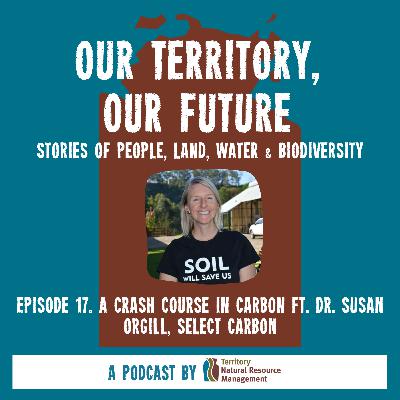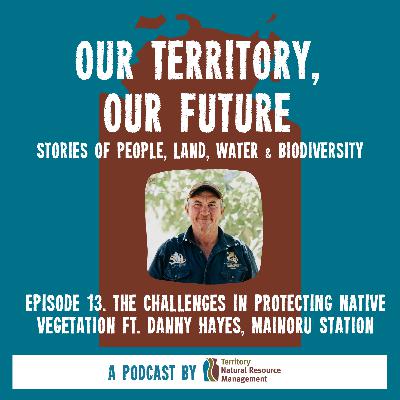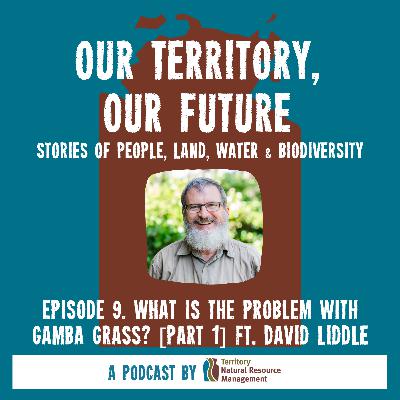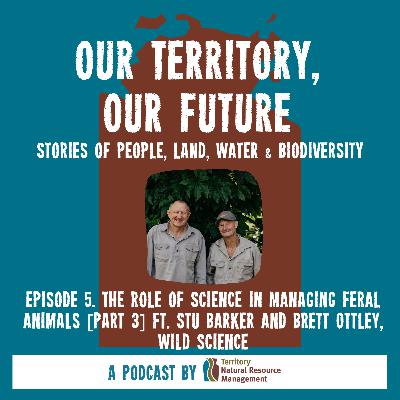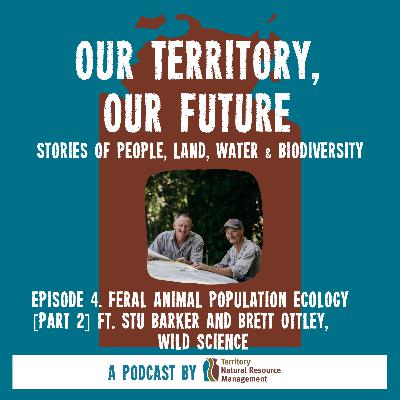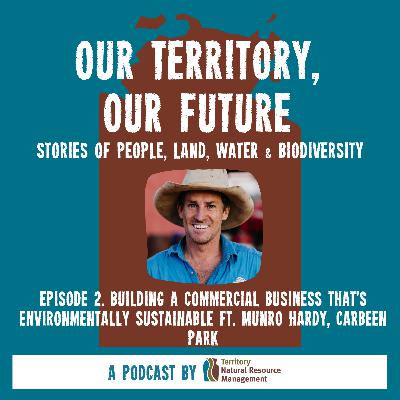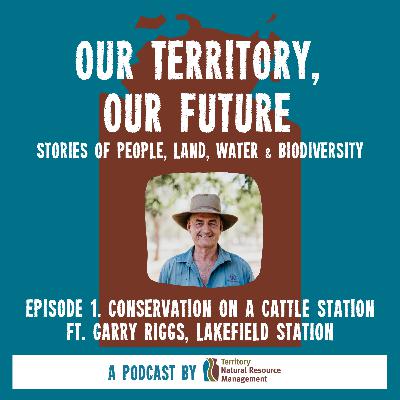Discover Our Territory, Our Future
Our Territory, Our Future

Our Territory, Our Future
Author: Territory Natural Resource Management
Subscribed: 4Played: 0Subscribe
Share
© 2023
Description
The Northern Territory is home to unique landscapes, flora and fauna.
In this podcast, we explore what landholders, community groups, industry and government are doing to ensure sustainable management of water, land, soils and biodiversity.
This podcast is brought to you by Territory Natural Resource Management - an independent, not for profit, organisation that develops, supports, and delivers projects to protect the natural resources of the Northern Territory and improve sustainability of all practices taking place.
In this podcast, we explore what landholders, community groups, industry and government are doing to ensure sustainable management of water, land, soils and biodiversity.
This podcast is brought to you by Territory Natural Resource Management - an independent, not for profit, organisation that develops, supports, and delivers projects to protect the natural resources of the Northern Territory and improve sustainability of all practices taking place.
17 Episodes
Reverse
Carbon – I bet you’ve been hearing a lot about it recently. But, what is Carbon, why is it so important, and is it just a buzzword, or is there more to the story?
My name is Steph Coombes, and in this episode I sit down with Dr Susan Orgill to learn about carbon, it’s role in the ecosystem, and how land managers can improve their soil carbon content for improved soil health, production outcomes, and carbon farming opportunities.
Dr Orgill is an applied soil scientist with over 15 years’ experience in soil carbon research and development, and to say that she lives and breathes all things carbon is an understatement!
This episode is supported by the Australian Government's National Landcare Program.
What is a biological product? How does it work, and when and where can it be used? And … Can they be used in the Northern Territory?
If you’ve ever thought the same questions, then you’re in luck!
My name is Steph Coombes, and in this episode I am joined by Simon to learn the broad strokes of biological products.
Simon Mattson is a farmer and a regenerative agriculture educator and consultant, who completed a Nuffield Scholarship on Soil Biology, and one of his many roles is teaching people how to make their own biological products for use on their own farm.
This episode is supported by the Australian Government's National Landcare Program.
Jeremy Bradley is a biological farmer and Senior (Adjunct) lecturer in regenerative agriculture at Southern Cross University.
Alongside his wife Cathy, he runs Beechwood Biological Solutions – a business which develops and distributes soil improvement products.
Using local microbes, Jeremy and Cathy have increased the soil organic carbon on their own farm by 45% to a depth of at least one metre and have shared their experience widely with the Landcare and farming community.
My name is Steph Coombes, and in this episode I sat down with Jeremy to learn about the hidden potential of using local microbes and fungi, and how they can be used in the Northern Territory.
This episode is supported by the Australian Government's National Landcare Program.
Managing soils in the Northern Territory comes with its own unique set of challenges. So, how do we overcome these challenges, and what steps can we take to not just protect Territory soils, but improve them for the generations to come?
My name is Steph Coombes, and in this episode I sit down with Fergal O’Gara - an agricultural consultant with over 30 years experience in tropical agriculture, how land manages can sift through the overwhelming amount of data and management options available, to effectively and sustainably manage their soils.
This episode is supported by the Australian Government's National Landcare Program.
Mainoru Station is a 1300 km2 cattle station, 250km north east of Katherine. In the 10 years since Danny and Cathy Hayes purchased it, they have been relying predominantly on native vegetation for the cattle production system.
In this episode Danny shares the challenges he has in managing his native pastures, including below average rainfall, grazing pressure from both cattle, feral animals, and wildlife, and of course weeds.
He also discusses the Territory Conservation Agreement he entered into, how and why he chose the site he did, and what he hopes to achieve.
A Territory Conservation Agreement supports land managers to protect areas of conservation importance on their properties.
They are a 10-year voluntary agreements between Territory Natural Resource Management (TNRM) and a land manager.
The program is supported through funding from the Australian Government's National Landcare Program. The agreement is a contract, but it is not registered upon the title of the property or binding to future owners.
My name is Steph Coombes, and for this episode I travelled to Mainoru Station to learn about how Danny manages his native vegetation, and what impact the Territory Conservation Agreement will have.
This episode is supported by the Australian Government's National Landcare Program.
When Gamba Grass was first introduced into Australia, many had high hopes for its value as a livestock feed.
However, today it is a declared weed of national significance.
My name is Steph Coombes, and in this episode I sit down with Diego Alvarez and James Pike, who both work with Gamba Grass under different projects run by Territory NRM.
Diego is a project officer who works alongside various stakeholder groups, including many Indigenous ranger groups operating in the Eradication Zone. In his role he supports land managers to achieve strategic gamba management with a view to eradication. Much closer to town, James has spent the last season leading the Gamba Army, operating amongst other stakeholders and land managers to achieve a coordinated Gamba management response across different land types and tenures in the greater Darwin area.
This episode is Part 3 in a 4 part series. In part 1 we heard from an ecologist to get the lowdown on Gamba Grass, in episode 2 we heard from Senior District Rangers about their experience managing Gamba grass in national parks, and in Part 4 we’ll hear from a local contractor about what’s involved in the fight against gamba grass.
This episode is supported by the Australian Government's National Landcare Program.
When Gamba Grass was first introduced into Australia, many had high hopes for its value as a livestock feed.
However, today it is a declared weed of national significance.
My name is Steph Coombes, and in this episode I sit down with Rod Edmunds and Steve Dwyer, both Senior District Rangers for NT Parks and Wildlife, to discuss how they manage Gamba Grass in National Parks. They share the story of how they managed Gamba Grass in their early career, and why they have changed their approach significantly over the past 20 years.
This episode is Part 2 in a 4 part series. In part 3 we will hear from project managers who work alongside various stakeholder groups to manage Gamba on under different land ownership and use, and in Part 4 we’ll hear from a local contractor about what’s involved in the fight against gamba grass.
This episode is supported by the Australian Government's National Landcare Program.
When Gamba Grass was first introduced into Australia, many had high hopes for its value as a livestock feed.
However, today it is a declared weed of national significance.
My name is Steph Coombes, and in this episode I sit down with David Liddle to discuss when, how and why Gamba Grass was introduced into Australia, and why it is now considered a highly invasive species which requires dedicated management and even eradication in some areas, to avoid the devastating impacts it can have on the environment.
David is an ecologist who has spent the past 40 years working in the Northern Territory, witnessing the process of landscape invasion by Gamba Grass. He unpacks for us many of the concepts and reasons which underpin the grass becoming problematic in the Top End.
This episode is Part 1 in a 4 part series. In parts 2 and 3 we will hear from various stakeholders trying to manage gamba grass in areas such as cattle stations, national parks and crown land, and in part 4 we’ll hear from a local contractor about what’s involved in the fight against gamba grass.
This episode is supported by the Australian Government's National Landcare Program.
The Northern Territory pastoral industry relies primarily on grazing native vegetation. It is in the utmost interest of pastoralists to care for native species, as well as maintain and promote biodiversity.
My name is Steph Coombes, and in this episode I am joined by Dionne Walsh to get an overview of native vegetation in the Territory, and what management strategies pastoralists are using to manage them effectively.
With a PhD in Rangeland Management, and more than 25 years of “dirty boots” experience, Dionne has a unique blend of academic rigour and practical know-how. To start our conversation, I asked her to give me an overview of native vegetation compared to improved pastures.
This episode is supported by the Australian Government's National Landcare Program.
When Doris Baylis and her husband took over the lease of Mataranka Station in 2016, they knew they would be busy - busy with infrastructure maintenance and cattle work, that is.
What they didn't bargain for was an annual, ongoing problem with wildfires.
It was, you could say, a true initiation by fire.
After losing almost 12,000ha to fires in 2017 and 2018, which equated to 15% of the properties grazing land, they knew they could no longer rely on traditional fire management.
So, they entered a Practice Change Partnership with Territory Natural Resource Management.
A Practice Change Partnership supports farmers to implement sustainable agriculture practices that will help protect native vegetation and biodiversity, and support the productivity of their operation.
These may be in the form of strategic weed and fire management plans, a change in water points, implementing new ag technology and different grazing methods for example.
The project is supported through funding from the Australian Government’s National Landcare Program.
My name in Steph Coombes, and in this episode I travelled to Mataranka Station to learn about how the Practice Change Partnership between Mataranka Station and Territory NRM works, and what the outcomes have been so far.
This episode is supported by the Australian Government's National Landcare Program.
When the Trembath family acquired “Lonesome Duck”, a 1000ha grazing and cropping property in the Katherine region of the Northern Territory, they managed the land using conventional farming practices.
It wasn’t until around 25 years later that the property began to transition from conventional to regenerative farming practices.
By his own admission, Jeremy states that in his early years managing the property, his choice to continue doing things as they’d always been done resulted in the soil health declining. It was until he was gifted a book on regenerative agriculture that Jeremy decided to do things differently and have soil health as the central focus of the entire agricultural operation. But, making the decision is one thing – knowing where to start, and actually starting, are a whole different story.
My name is Steph Coombes, and in this episode I sit down with Jeremy to learn about the practice changes he has implemented on Lonesome Duck over the past several years, what’s worked, what hasn’t, and where to next.
This episode is supported by the Australian Government's National Landcare Program.
This episode is the final part in a 3 part series about principals of feral animal management in northern Australia.
My name is Steph Coombes, and in this 3 part series, I’m joined by Brett Ottley and Stu Barker, the team behind Wildscience - a company which uses science and on the ground experience for wildlife and feral animal management.
In parts 1 and 2 we explored what a feral animal is, how they came to be in Australia, how their populations have thrived and how the population ecology of feral animals differs from domestic animals.
In this episode, we discuss why feral animal population management differs from domestic animal management, what options landholders have, and the important role that science plays in designing effective management plans.
This episode is supported by the Australian Government's National Landcare Program.
This episode is part 2 in a 3 part series about principals of feral animal management in northern Australia.
My name is Steph Coombes, and in this 3 part series, I’m joined by Brett Ottley and Stu Barker, the team behind Wildscience - a company which uses science and on the ground experience for wildlife and feral animal management.
In part 1, we explored what a feral animal is, how they came to be in Australia, and how their populations have thrived.
In part 2, we discuss how the population ecology of feral animals differs from domestic animals, and how that impacts their management.
Be sure to tune in to part 3 to hear about the management options and factors that need to be taken into consideration to ensure effectiveness.
This episode is supported by the Australian Government's National Landcare Program.
When you hear the word “feral animal”, what comes to mind?
Do you know what counts as a feral animal, as opposed to wild and domestic animals?
And do they have a place in our environment, or should we be trying to eradicate them?
My name is Steph Coombes, and in this 3 part series, I’m joined by Brett Ottley and Stu Barker, the team behind Wild Science - a company which uses science and on the ground experience for wildlife and feral animal management, to explore all these questions and more.
In part 1, we explore what a feral animal is, how they came to be in Australia, and how their populations have thrived.
Be sure to tune in to part 2 and 3 as we discuss how the population ecology of feral animals differs from domestic animals, and the principals of feral animal management in northern Australia.
This episode is supported by the Australian Government's National Landcare Program.
Carbeen Park is a 8000 ha grazing and broadacre property in the Katherine region.
In additional to a 40 hectare pivot, and large scale dryland fodder production program, the property is also home to a cattle feedlot with registered spelling and dipping facilities.
In 2022, a local business, the National Feed Company, acquired the lease to Carbeen Park with plans to use the property to supply hay to their local feed mill.
However, there is much more going on at Carbeen Park that meets the eye.
My name is Steph Coombes, and in this episode I sit down with Munro Hardy, manager of Carbeen Park, to discuss the approach being taken to reinvigorating the property, and how their plans to generate cashflow are being guided by a focus on soil health.
This episode is supported by the Australian Government's National Landcare Program.
When Garry Riggs and his family acquired Lakefield Station in 1999, it was a bare block.
Located on the Sturt Plateau, Northern Territory, Lakefield is home to savannah bushland, floodplains, swamplands and freshwater lakes, with an annual average rainfall of 800mm, delivered often in a tropical wet season.
As development infrastructure to support cattle production on the 58,000 hectare property progressed, so did the development of conservation sites.
In this episode Garry shares his experience of working with Territory Natural Resource Management over the past decade on two projects – a Territory Conservation Agreement, and a Practice Change Partnership.
A Territory Conservation Agreement supports land managers to protect areas of conservation importance on their properties.
They are a 10-year voluntary agreements between Territory Natural Resource Management (TNRM) and a land manager. The program is supported through funding from the Australian Government's National Landcare Program. The agreement is a contract, but it is not registered upon the title of the property or binding to future owners.
My name is Steph Coombes, and for this episode I travelled to Lakefield Station to learn about the TCA and PCP projects.
Just a heads up – this episode was recorded at the homestead, so you might hear some authentic background noise from time to time.
This episode is supported by the Australian Government's National Landcare Program.


